Scottish kitten weight by month
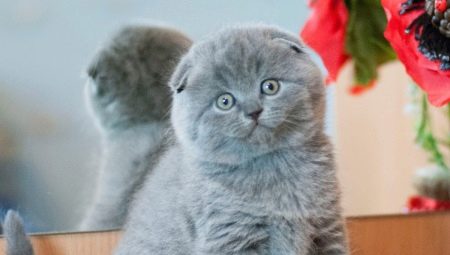
Exotic breeds of cats and cats make owners and breeders carefully monitor their health status. Underweight or overweight is a sign of health problems: as a result, this can significantly reduce the life span of a cat or cat. In addition, it is easy to estimate what quality of the breed the pet will eventually grow up to.
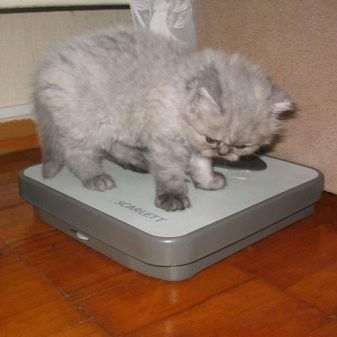
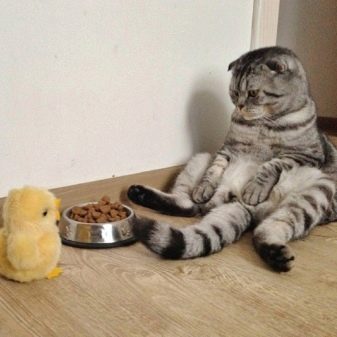
General information
Scottish cats are not particularly large in size, this breed looks more graceful than British. It does not matter whether he has straight ears or drooping - the weight distribution over the months of the first year of life will be the same.
The Scottish cat is distinguished by developed muscles: the muscles of the body are well developed, and the body length and weight are average. An adult cat or cat weighs 5-7 kg. It happens that the weight is noticeably more - from 8 kg, the answer to the question about the weight norm is ambiguous here.


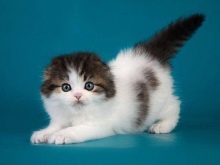
How much does a newborn kitten weigh?
At birth, not only the norms for a single kitten are important, but also the total number of kittens when there are more than one. If, for example, 5 kittens were born, then the weight of each will be much less than if only 3 of them were born. The womb of a cat, in which they were formed before birth, is limited throughout its life. There is nowhere to get free space - there is a limit for every adult female. Nature has come up with a way out of the situation by reducing the weight of each of the cubs born to this individual.
Subsequently, the weight of each kitten will approach the age norm of the first year of life, but it is worth providing all kittens with additional complementary foods when the mother cat produces little milk. The typical birth weight of Scottish kittens is 60-140 g... If the cat is provided with an adequate diet, rest and walking, then the kittens will not have a critical underweight.

Weight dynamics in the first weeks of life
For the first 2 weeks, each Scottish kitten gains an average of 15 g per day. It is necessary to provide adequate nutrition for the cat itself. Her additional complementary feeding with milk formulas, created for kittens, is also suitable in case this cat, for example, would die during childbirth. A little over-feeding will not harm the cat: later she will give all the excess feed to the kittens through the same breast milk.
At the end of the "breast period" of kittens, she will adjust her normal weight herself. During the first week, the weight of each kitten will grow on average by more than 100 g. The total weight of a kitten in 2 weeks from the moment of birth will reach an average of 270 g. Small cats are 1.5 times lighter than males.
At 3 weeks, kittens are given additional complementary foods to accelerate weight gain (if necessary). The third week of a kitten's life will bring its weight to an average of 400 g.
If the kitten continues to gain weight normally, then you can still rely on the mother cat, but not for long. The day comes when the kitten still needs to be fed with high-quality cat food, so that the later grown cat or cat does not face a number of diseases, including age-related ones.


Weight in the first months of life
By the end of the first month of life, kittens will gain an average of 0.5 kg of weight. By 2 months, the weight is approaching or exceeding a kilogram. After the 3rd month, the weight is set at around 1.5 kg or more. 4 months after birth, each of the kittens "grows heavier" on average up to 2.8 kg.
The rate of weight gain is non-linear - by the end of the first year of life, growth slows down until it stops (adult male or female "Scotsman"). From the 5th month, the body weight gain begins to slow down, and the kitten reaches 3.2 kg. When tracking the dynamics of weight gain, approximately 20% of the situation is predetermined by the genetic data of both parents. A half-year-old kitten weighs about 2 kg on average.
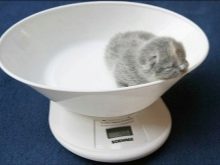
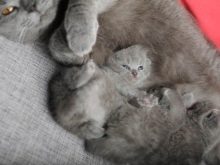

Starting from six months, the table of the weight of a growing cat or cat is kept to the following average values: by the end of the 7th month - 4.5 kg, in the 8th - 4.8, in the 9th - 5, in the 10th - 5.2, in the 11th - 5.3 kg. By the beginning of the next year, a young cat or cat should weigh approximately 5.4 kg. An adult cat is often twice as heavy as the same cat: it can weigh 6 kg, she - 3 kg. From this point on, the cat or cat is considered an adult.
Of decisive importance in the weight category are the amount of feed, weather conditions (if the animal goes out into the fresh air), the absence of acquired chronic diseases and genetics. Often it turned out when the cat was "fed", giving him above the norm, which is why he gained maximum weight - up to 7.5 kg. Further overkill or undershoot is no longer the norm by 100%.
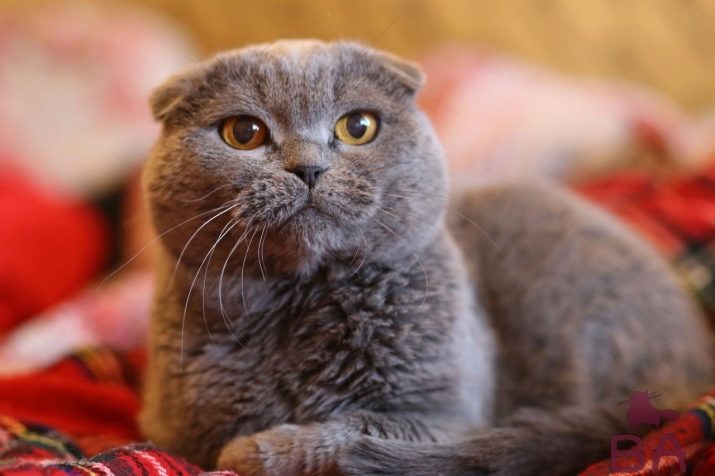
Feeding in the first year of life
Like kittens of other breeds, Scottish up to 3 weeks consume only breast milk. If an accident occurs, for example, a Scottish cat died during childbirth, from malignant diseases or in case of accidental poisoning, or ran out onto the roadway, refused to feed kittens and other accidents, then orphaned kittens will do well with milk formulas that are extremely close in composition to cat's milk.
Good products are produced, for example, by a company Royal Canin, specializing mainly in dog and cat food. Manufacturers of such products make sure that the fat content does not exceed 10%, and the vitamin content of the formulations is sufficient for the growing body of dogs and cats.
If there is no specialty shop or veterinary clinic with a mini-store nearby, where you can find food for any kittens and puppies, act on your own. Country (farm) milk to reduce fat content it is bred in half with boiled water, or the cream is removed from it and the newborn kitten is allowed to taste it. They start to unsolder it, from day to day, gradually reducing the number of meals per day, but increasing the volume of each complementary foods.
As a basis, you can take the nutrition of any average outbred kitten - all kittens consume approximately the same amount of milk. A specific breed - all the same Scottish cats - require their own amount of food in the first days and weeks of life, but you can save your ward's life and let him grow up, adhering to the norm of "street" kittens.
The main thing is not to overfeed, not underfeed and do not forget about the regularity of feeding, otherwise the kitten will be late in gaining weight, it will not develop quite correctly, which will lead to illness and its premature death later.
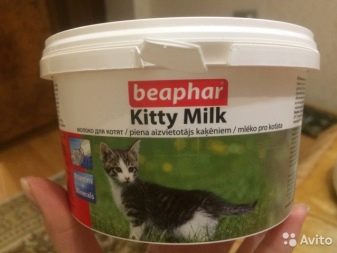

What to give?
After about 20 days of life, it is permissible for the kitten to enter another complementary food. Whether it's industrial feed or boiled beef / chicken, try to stick to the same dietary line. If you do not have time to cook a piece of meat for him every day or two, you will want to switch to dry food, but this should be done gradually so that the kitten's body has time to adapt.
It is in the first months of life that the cat develops taste preferences, which he will adhere to. After a month, a kitten can be weaned from consuming milk alone. An adult cat does not live long on milk alone - he needs other products.
In the first days of complementary foods, do not strive to immediately give, in addition to meat (or feed), several other products, such as: boiled egg yolk, black bread, broth. This is not an adult cat yet, and the kitten may have indigestion. A cat is not a person, on the very first day he will not stand such a variety, he will simply vomit, act gradually.
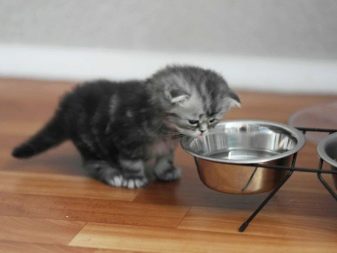
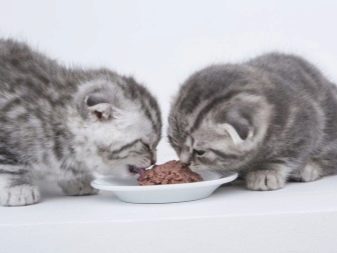
If your goal is to diversify your Scottish kitten's diet, do not mix several foods in one meal. If a rash develops under the tail of a kitten, then this is already an allergy. By reacting in a timely manner, you will eliminate the product that caused it. In addition to the general rules of the diet, each animal has its own "unloved" product.
Raw yolk is served according to the same recommendations as milk with cream. As for industrial food, kittens that have just stepped over one month of age need to be soaked beforehand. After 1.5 months, that is, at the age of 2.5 months, they will learn to eat it dry, but do not forget about regularly pouring fresh water into the "drinker".
Before the kittens are 3 months old, do not give them canned food and raw minced meat - the digestion processes do not immediately self-adjust to assimilate such products. After three months of age, the kitten's diet approaches that of an adult cat or cat. Mother cat should be protected: too late feeding of kittens with natural cat milk can lead to exhaustion and early aging of her body. Everything is good in moderation, and experienced breeders are clearly aware of this.

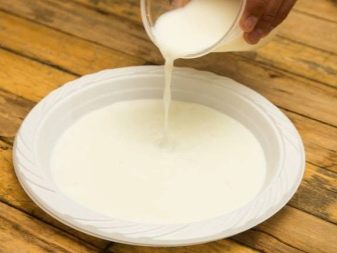
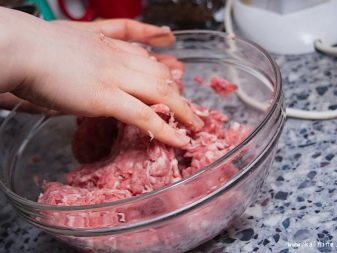
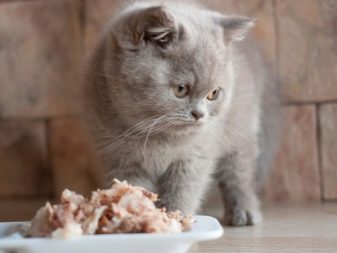
What are the risks of gross violations of the diet?
Overfeeding can lead to premature wear and tear of the gastrointestinal tract, in particular, to problems with the liver and pancreas. The same applies to the use of cheap, low-quality feed, since the cat is not a rooster, he cannot digest, for example, low-quality grain.
An attempt to transfer exotic cats raised on feed to bones and other products from the human table will only bring a negative result. Such an adventure often ends with the death of these animals - they flatly refuse to eat.

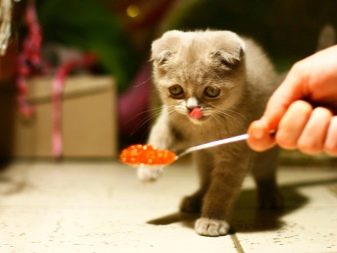
Breeders' tips on how to feed kittens properly are presented in the video below.
































